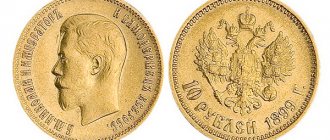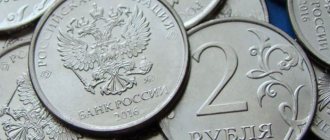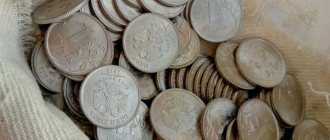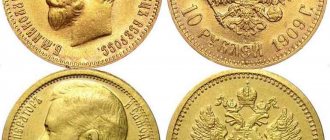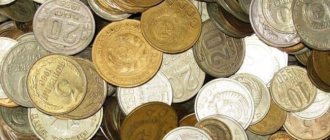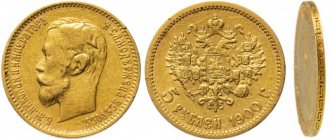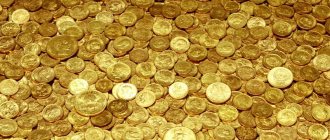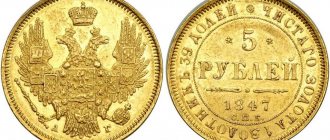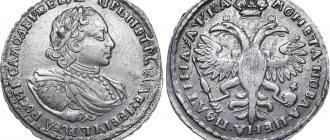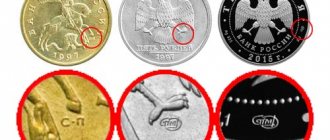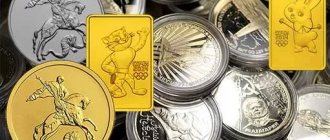Literate people believe that the most expensive coins of modern Russia are presented as exhibits in some museum. Others believe that these coins are a rarity that is not found in an ordinary wallet. And that, probably, their obverse is nothing more than a page of history minted from precious metal.
Only a true connoisseur will take a closer look at every coin that ends up in the palm of his hand. An expensive copy can be found among ordinary nickels of the 2000s, the main thing is perseverance and attention.
Some of the most valuable coins
Since money itself is a value and plays a key role in the development of a country, people have always depicted the most important events with general cultural and historical value on them. These could be natural monuments, political or cultural figures, folk symbols, state attributes, etc.
But the list of expensive modern Russian coins demonstrates that these qualities are not always important.
One tiny nuance, invisible to the eye, one small and accidental deviation from the standard - and in front of you is a rare specimen, worthy not only of attention, but also of a substantial monetary reward from a passionate collector. In tens of years, these coins will acquire historical value, but for now it lies in their dissimilarity with other coins.
Finding a unique and different person is easier than ever. Everyone has a mole, a special shape of eyebrows, etc. If coins are put into circulation in circulation of many hundreds of thousands, then even a slight difference indicates its rarity, despite the fact that this is a common manufacturing defect.
Which coins can be sold at a high price: table
Banknotes that were produced at the same factory, but during the minting process minor differences appeared on them, are called varieties. They are systematized and described in catalogs. The value of such specimens increases. Price table for coins that can be sold at a high price:
| Year of issue | The reason for the rise in price | Market value, rub. |
| 1924 | The letters "USSR" are elongated | 100000 |
| 1929 | The last nine in the year of production is smaller in size | 300000 |
| 1937—1940 | Defective stamps were used for minting, which led to a split in the contours of the obverse side | 100000 |
| 1947 | Trial series of the Leningrad Mint | 350000 |
| 1950 | Roundness of zero in date of manufacture | 200000 |
| 1957 | 16 ribbons in the coat of arms versus the usual 15 | 376000 |
| 1963 | Raised coat of arms, leaving no gap between the edge and the coat of arms | 28800-34300 |
| 1980 | Long awns on obverse | 13700-22500 |
| 1991 | Copper clad, small edition | 46250-63333 |
| 2011 | Trial consignment | 150000 |
| 2017 | Rarely seen specimen | 8700 |
The increase in value occurs due to minor changes in minting batches of coins. You can sell rare models on the market, take them to an antique store, or sell them at auction.
Ten-ruble note “No One is Forgotten”, 2005
In 2005, in honor of the 60th anniversary of Victory in the Second World War, another ten anniversary coin “No One is Forgotten” was issued, which is one of the most expensive anniversary coins in Russia. The total circulation was 60,000,000 copies.
During the first few years after this coin was made, they were not rare. They actively participated in money circulation, and were also confiscated, replenishing collections and piggy banks. But today it is almost impossible to get such a copy with change.
Features of the banknote
In the manufacture of this ten-ruble coin, two materials were used - cupronickel and brass.
The obverse of the product has the usual design common to all bimetallic coins. The disc (nickel silver) contains the denomination in 2 lines, as well as the mint logo. On the rim you will see the release date and the inscription “Bank of Russia”. In the central part there is a denomination, framed on both sides by drawings of an olive tree and oak branches.
On the reverse you will see the eternal flame and the St. George ribbon, as well as the war years (1941-1945), during which bloody battles took place. The brass ring contains the catchphrase: “No one is forgotten, nothing is forgotten.” Below is an olive branch.
Price of ten rubles
The large circulation undoubtedly influenced the value of the coin, as well as the degree of interest in it from collectors. But the price of a copy in good condition varies between 60-80 rubles.
Valuable varieties of coins
The value of a coin is determined by its state of preservation and rarity. The rarity of the currency depends on the year of issue, the name of the mint, and manufacturing defects. Signs of coin value:
- Excellent condition. It will be difficult to sell copies with scuffs and traces of corrosion.
- Coinage from St. Petersburg is valued higher. This is due to the fact that the volume of minted kopecks in the city on the Neva was much smaller than the Moscow batches.
- A rare specimen. There is data on the number of coins minted at different times. Over time, the fewer coins are in the field of view of numismatists, the higher their value.
- Presence of marriage.
Important!
To determine the value of a particular specimen, it is better to seek the help of specialists.
The final price is influenced by the presence of the smallest differences, which professional numismatists are able to find and understand.
So little things
First, let's start with relatively inexpensive, but still quite rare coins. There are two of them, both bimetallic 10 ruble coins, both of which appeared in circulation in 2010.
- 10 rubles in honor of the 2010 Population Census - the cost of this coin today is 300-500 rubles, depending on its condition;
- 10 rubles Nenets Autonomous Okrug - the cost is about the same, 300-500 rubles.
Types of marriage
In the production of metal banknotes, there may be cases of defects, photos of which can be found on the Internet. These include:
- Split stamp. The consequence is the appearance of a convex line on the surface of the coin. The thicker this line, the higher the cost. The price of a copy with a split can range from 200 to 1500 rubles.
- Bite. If there are several of them on one coin or one, but deep, the cost can be more than 1000 rubles.
- Image offset. The asymmetry of the edge of a penny coin can raise its value to 600 rubles.
- Double obverse image. On one side the image contains the inscription “1 kopeck”; on the opposite side, due to the sticking of the minted coin, a negative of the inscription was imprinted in the stamp. This type of marriage is very rare and valuable. The price of this type of marriage can reach up to 10-15 thousand rubles.
- Turn. The obverse is rotated 180° relative to the reverse. This type is estimated at 2300 rubles.
- Unminted. A defect associated with wear of the stamp, leading to complete or partial unreadability of the image.
The value of a 1 kopeck coin increases over time. Kopecks from the USSR can be sold on average at 50,000 times their face value. Unique Russian coins can also become an unusual source of income.
Rare pennies from 1997-1998.
During these years, a huge number of coins of all denominations, including penny ones, were circulated. There are no truly rare or expensive coins among them, but if you come across coins from 1997 and 1998 in absolutely perfect condition, you can sell them for 10-50 rubles.
But the coins must have no traces of use at all, and their stamp shine must be the same as it was when the coin was first taken out of the bank bag.
Expensive 10 rubles: anniversary and regular coinage
Many numismatic collections began with a few commemorative coins that they did not want to put back into circulation. Commemorative issues of the first decade of the 21st century were just that. Bimetallic coins were so different from all the others that two-color ten-ruble coins were put aside even by those who had not even thought about any collection. Get 10 rubles
with the emblem of the ministry, the coat of arms of the region or a view of the ancient city did not seem surprising then. And the coin in honor of the 60th anniversary of the Victory, affectionately called “Ogonyok” by numismatists, was found as often as a ruble with Lenin’s head during the Soviet era.
Anniversary 10 rubles, which are expensive
Rare 10 rubles 2010 “Perm Region”
Everything changed in 2010, when the next ten-ruble notes of the “Russian Federation” series were minted by the St. Petersburg Mint in a non-standard edition. But if the number of 10 rubles in 2010 “Nenets Autonomous Okrug” was reduced by about five times (1,950,000 pieces), then “Perm Territory”
Only 200,000 copies were released. The circulation was sent to the regions, and at first, coins of the series could often be obtained as change, despite such a small quantity. After the circulation became known, the bimetallic coins instantly disappeared from circulation.
Rare 10 rubles 2010 “Chechen Republic”
The exception immediately became the “Chechen Republic”
, the location of most of the circulation of which (100,000 pieces) was unknown for a long time. There was a sharp rise in prices at the beginning of 2011, as there was a terrible shortage of these coins on the market. A few years later, some of the bags returned from oblivion, and mass sales of stamped coins began. However, based on the circulation, prices for this ten-ruble note continue to remain high.
Rare 10 rubles 2010 “Yamalo-Nenets Autonomous Okrug”
Champion in price among the anniversary - "Yamalo-Nenets Autonomous Okrug"
. Almost the entire circulation of this coin (100,000 pieces) went into circulation, so some of it is irretrievably lost, and most copies have lost their shine or received scratches during circulation. Therefore, the cost of a coin in perfect “Unc” condition can exceed 20,000 rubles.
Rare 10 rubles 2010 “Alania” (magnetic)
This is another rare coin from the “Russian Federation” series, but only if it has pronounced magnetic properties
.
A small part of the 2013 edition of 10 rubles “North Ossetia – Alania”
was minted in an experimental alloy. The first copies found easily sold for 10,000 rubles. But then the hype around it died down, and the price dropped noticeably. “Alania” is also notable for the fact that some coins have an erroneous edge design, obtained from the “Sochi” 25-ruble notes.
List of rare anniversary 10 rubles with prices for September 2021 (the cost greatly depends on the condition, so we give the lower limit):
- 10 rubles 2010 “Yamalo-Nenets Autonomous Okrug” - from 14,000 rubles
- 10 rubles 2010 “Chechen Republic” - from 6,000 rubles
- 10 rubles 2010 “Perm region” - from 4,000 rubles
- 10 rubles 2013 “North Ossetia – Alania” (magnetic) – from 3,500 rubles
- 10 rubles 2010 “Nenets Autonomous Okrug” - from 450 rubles
- 10 rubles 2010 “Census” - from 400 rubles
- 10 rubles 2013 “North Ossetia - Alania” (flock error) – from 200 rubles
Coins from the “Ancient Cities of Russia” series, the circulation of which was divided between MMD and SPMD, are also valued an order of magnitude higher than their face value. In addition to bimetal, the Central Bank also puts into circulation anniversary steel tens with brass galvanization, but rare items are not yet listed among them.
Rare 10-ruble coins of regular mintage
These coins first appeared in 2009. The Bank of Russia announced them as a replacement for paper money of similar denomination, the printing of which they decided to stop. At the time of release, the popularity of the new coins was so high that the Administration of one of the regions even published an explanatory letter urging citizens not to keep everyday coins, but to return them to circulation, since they have no numismatic value. The history of the steel ten-ruble note with brass galvanizing has only just passed its first decade, but it has already recorded positions that are a collector’s dream.
Table of issue of regularly minted coins (10 rubles)
Above is a table that identifies infrequent and rare 10-ruble coins, highlighting the presence of rare varieties for a particular year (these varieties can be found in circulation). Catalogs show that some varieties are very rare. And this is true, but the demand for them is not so high. We took into account the demand tables of the Escande catalog, which clearly show that a rare variety (a minor difference in an element or a miniature shift in the mint mark) is often not an expensive coin.
10 rubles 2011, 2012 and 2021 SPMD
With the exception of 2010, any 10 rubles of regular mintage with the SPMD emblem
under the paw of an eagle is the subject of close attention of Russian numismatists. Since 2011, the Central Bank has given orders for the minting of annual coins primarily to the Moscow Mint. But SPMD is also ready to get involved in the work, so before the planning period it prepares stamps of all everyday coins for which an order can be received. SPMD proof coins periodically penetrate into the numismatic market through mysterious ways. Of the 10 rubles, coins of 2011, 2012 and 2021 are known. However, it is useless to look for them in wallets and piggy banks. The value of such coins is indicated by their auction passages. For example, a ten-ruble note from 2011 with the SPMD sign was sold in March 2014 for 254,200 rubles, and a month later for 103,500 rubles. But we are talking only about regularly minted coins. 10 rubles from the “Cities of Military Glory” series of 2011, which were also minted by SPMD, have nothing to do with rare coins.
Rare varieties and their cost
Differences between the reverse stamps of 10 rubles 2010 SPMD
And yet, the St. Petersburg 10-ruble note with the date “2010,” which is still often found in circulation, has a variety that collectors are willing to pay for. This year, SPMD coins were minted with two types of reverse. Most of them have a reverse “Pieces”. 2.51". The smaller part is minted with the stamp “Pieces.” 2.4". Its peculiarity is that the horizontal lines touch the walls of its internal opening at zero. The differences under magnification are shown above. For a well-preserved copy you can get from several hundred to a thousand rubles.
Differences between the obverse stamps of 10 rubles 2013 MMD
From the Moscow weather calendar, 10 rubles from 2013 stand out, where the lower tail of the troika in the date is not rounded upward, but pointed and points downward. A photograph of this test coin has been wandering around the World Wide Web for a long time. But the calls “Don’t miss the change!” cause only a gloomy smile in her regard among experienced collectors. Such a copy could not have appeared in circulation even by accident.
Differences between the obverse stamps of 10 rubles 2021 MMD
Another interesting example of an expensive variety is 10 rubles in 2016. Numismatists were presented with a specimen where the MMD monogram is not located in the middle between the letter “I” and the eagle’s paw, but is shifted towards the orb. Since no other similar coins have been found so far, the specimen is considered controversial. No one paid the 30,000 rubles requested by the seller for the coin.
Differences between the reverse stamps of 10 rubles 2012 MMD
But here is a very interesting “variety” that can no longer be found in modern catalogs. Stamp "Pieces" 1.2”, which was found exclusively on coins of 2009, was suddenly discovered on a ten-ruble note with the date “2012”, which was immediately bought for 26,000 rubles. A characteristic feature is a thick bottom line at zero, resembling a semicircle. But when coins from 2013 and then 2015 were put up for sale with the same reverse, collectors began to suspect that they were produced on MMD. Careful examination revealed similar mechanical defects on all coins. As a result, these items were recognized as fakes and excluded from catalogs.
Coins of 2009 with the reverse “Pieces” still remain in demand. G", "Pcs. D1" and "Pcs. D 2". However, to identify them, you will need precise measurements of the location of the MMD monogram, and they will not bring a lot of money. Very rare are coins from 2017-2020, whose reverse is not made with the standard stamp “Pieces.” 2.52", and "Pcs. 2.2", but these copies are still considered “custom” products, which will be discussed in the next section.
Rarities of a “custom” nature
Another category of rare and expensive coins consists of specimens that numismatists contemptuously call “zakazukha”. Experts recognize them as products of the mint (most often, these are MMD), but they say that this is a purposeful coinage for sale to collectors looking for all sorts of unusual things. Let's look at a few of these coins.
10 rubles 2021 “Olonets” on blank from 25 rubles
Very often, 10-ruble notes from the “Ancient Cities of Russia” and “Russian Federation” series, made in single-color nickel silver instead of bimetal, are offered for sale. For example, all positions for 2021 are known in this form: “Olonets”, “Ulyanovsk region” and “Tambov region”. Until recently, the approximate price of such a product started at 7,500 rubles. However, there are a few exceptions. One of them is 10 rubles 2006 “Sakhalin Region”
, sold for 91,000 rubles. Collectors were attracted by the uniqueness of the specimen, the date of minting (there was no influx of custom-made items during this period) and the material (nickel silver).
10 rubles “Stary Oskol” 2014 and 2015
Date errors on coins are a separate and long-recognized area of collecting. In the mid-2010s, they decided to contribute to it by releasing many coins with a date different from the catalog date. For 10-ruble coins this is “Stary Oskol”
(date “2015” instead of “2014”). The vast majority of the positions in the “City of Military Glory” were minted by St. Petersburg, but its coins did not appear anywhere as a date mix-up. The price of such coins ranges from 12,000 to 20,000 rubles.
Hybrid coin: obverse from 10 rubles, reverse from the PMR ruble
The crown of MMD’s numismatic creativity among the 10-ruble coins so far remains the 10 rubles of 2015 “Korolev”, which are missing from the Central Bank database. An amazing coin without reference to any anniversary of the brilliant Soviet designer has excited the numismatic world. But in 2021, a commemorative ruble of Transnistria appeared with the same composition on the reverse, and everything fell into place.
10 rubles 2021 “Rzhev” without indicating the denomination on the edge
Another interesting type of technological defect is the absence of an inscription on the corrugated edge of the bimetal. Copies of recent years, widely represented on the market, are traded at a price of 2000-4000 rubles. However, there are exceptions here too. Coins from the early years of minting without edge inscriptions are very rare and are highly valued. For example, “Arkhangelsk region”
(2007) finished at the auction with an amount exceeding ten thousand. It's good to know about these coins. After all, even a “custom-made” specimen could hypothetically end up in circulation from a scattered collection, an attempt to legalize a position, or a joke from a wealthy numismatist who decided to see what kind of furore would arise on the forums when someone found such a coin in circulation. After all, despite the “custom” nature of the coinage, the mint’s products remain a coin that will be accepted in a store as an ordinary ten-ruble note.
Unusual expensive coins 10 rubles
In conclusion, a few words about interesting ten-ruble notes that have a high price, which were not officially minted for everyday use. First of all, we mention 10 ruble coins made of gold (1.55 and 1.555 grams) and palladium (15.55 grams). Their minimum price can be calculated based on the daily stock exchange reports of the Central Bank, multiplying the cost of a gram of metal by the weight indicated on the obverse. But ideally preserved specimens also have additional numismatic value.
10 rubles 2008 “Azov” MMD (trial copy)
And this is a representative of coins that also cannot be caught in change. Despite the fact that we are looking at the position of the “Ancient Cities of Russia” series, the color and inserts and rings will surprise anyone. No, this is not hand plating. This is one of the test samples that appeared to visitors of the numismatic exhibition. With the help of such specimens, the mint demonstrates its capabilities to customers. Once up for auction, one of these coins surpassed the 100,000 ruble mark.
Collectible 10 rubles 2014
Brass ten-ruble note 2014 “Bronze medalists”
also included in the group “Valuable 10-ruble coins of modern Russia”. This is the most desirable position for someone who has decided to collect a complete collection of 10-ruble coins made of base metals. At auctions it goes for an amount from 40,000 to 50,000 rubles. The high price is explained by the circulation of the coin - only 500 copies. This one will not get lost among everyday coins, because with a diameter of 75 mm and a thickness of 8.5 mm, its weight is 292 grams.
